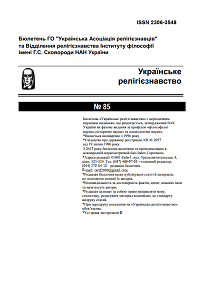State Toleration of a New Faith in Post-Soviet Society: A Case Study of Latter-day Saints in Independent Ukraine
DOI:
https://doi.org/10.32420/2018.85.698Keywords:
toleration, religious liberty, freedom of religion, non-toleration, limited toleration, full toleration, pluralism, LDS Church, state policyAbstract
This study combines author's experiences as an analyst of post-Soviet politics and religious liberty with personal participation in the founding and public acceptance of a new faith in independent Ukraine during a quarter- century (1). The
attempt here is not only to describe a specific outcome, but to propose factors that offer explanation for why Ukraine is among the few Communist successor states in which new minority faiths have been relatively successful in achieving full toleration [Biddulph: 2016].
Religious liberty has been described as the “first freedom of all freedoms” [Hertzke: 2013, 4], yet it has been noticeably unachieved globally. A 2007 Pew “Global Attitudes Survey” showed that 90% of respondents world-wide said that it was important to live in a country that enabled them to practice religion freely.
Yet a more recent Pew “Forum on Global Restrictions on Religion” found that 70% of the world population reside in countries which have high or very high restrictions on religion either from government actions or from major social hostilities [Grim: 2013 , 86]. Religious liberty, therefore, is an almost universal human aspiration, but is one of the more unachieved rights in the world. The Soviet Union successor states have a similar record of lower achievement [Lunkin: 2013; Grim: 2013].
Downloads
Published
Issue
Section
License
Copyright (c) 2018 Howard L. Biddulph

This work is licensed under a Creative Commons Attribution-NonCommercial-ShareAlike 4.0 International License.


